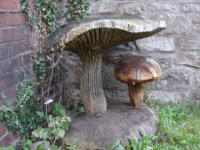
A chainsaw carved log is almost guaranteed to crack, often unpredictably, and, to a greater or lesser extent. Nearly all chainsaw sculptures are carved from “green” timber. This means that the timber has been relatively freshly felled and hasn’t sat around for long enough to lose a significant amount of moisture. It might be asked “why not wait for the wood to dry out (season) before carving it”, but this won’t work very well. In the UK it takes a very long time to dry a section of timber more than around 50mm thick. Round logs may take several years, large round logs, tens of years. With most large round logs, they will rot before they dry. When carved, they dry out at an accelerated rate.
In order to inhibit the cracking, the drying rate of the carving has to be slowed down. To begin with, it must be kept out of direct sun. If it is to go indoors, it must start acclimatising somewhere cool and not too dry, perhaps a garage. Bringing it inside immediately will likely cause it to crack quite badly. A cool shady spot is best for a few months until it slowly dries to a similar humidity as its surroundings. At this stage, give it a lick with a timber preservative to discourage surface moulds.
After a couple of weeks of dry weather, a new carving should be treated with more timber preservative. There are a number of these on the market, nearly all water based. If a white spirit based preservative is available, it should be used in preference. Apply as much as the carving will take, some timbers are more porous than others.
When the preservative is dry, a coat of oil like decking oil or Danish oil can be applied. Three or more coats of the oil will help to seal the surface of the carving and slow down the rate the remaining moisture can dry from the carving, thereby reducing the cracking. It will also help prevent the carving from soaking up any rain.
The carving should not be allowed to sit directly on the soil. Nor should it sit directly on a surface such as concrete or plastic sheet that allows water to collect under the base. This water, from the soil or the concrete, will wick up into the carving and rot the base. The carving is best sitting on coarse pebbles to allow air under the base and water to drain away.
It should be treated with more preservative and oil on an ongoing yearly basis.
It is worth reading my write up on Timber Drying Defects in order to understand what is going on when carvings dry out. It may also help to know the natural durability of the timber your carving is made from. Read Sculpture Timber Durability.
There is no easy way to stop the carving weathering and bleaching to a driftwood colour after a year or so. A timber stain can restore dark colours.


